(ProLight Opto PK2N series 'Phenix 3535', left: 515nm cyan, middle: PC-amber, right: 435nm)
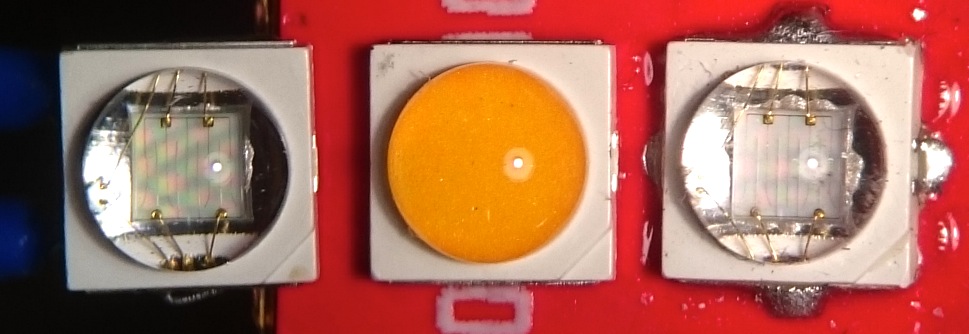
When browsing RS-online for newly listed leds I came across the ProLight brand. It caught my attention because apart from white leds they carry a fairly wide range of colour leds that have the common XP-footprint. Apart from Cree I was not aware of quality 3535-size colour leds, the Luxeon Rebel, Luxeon Z, Luxeon C-colour, Cree XB-D and XQ-E, and Ledengin leds have their own distinct footprint for which it is not easy to get boards, let go DTP-copper ones. I have some Rebel Sinkpads, but Rebels are very hard to fit and center under a reflector.
ProLight Opto appears to be a Taiwanese company, and their leds, that come with a proper spec-sheet, have good specs. So I bought a few more exotic wavelengths from the PK2N series: 435nm (PK2N-3LLE-L, $2.20 a piece), 515nm cyan (PK2N-3LCE-SD, $1.30 a piece), and PC-amber (PK2N-3LPE-ASD, $0.90 a piece). The die size of the various PK2N seems to be in between the XP-G and XP-E. I had an XP-E2 PC-amber waiting for a mod someday, so that would be a good comparison. I would have liked to have used a cyan Rebel and a PC-amber Rebel for comparison as well, but apart from the extra work that would take, I simply did not have any.
PC-amber leds are royal blue leds with a phosfor layer, just like all white leds, with the difference that all blue light is converted into a broad band at the longer wavelength side of the visible spectrum, lots of yellow,orange,red, only little green and no blue. As an aside, the Cree XP-E2 PC-amber led appeared to have a XP-G size die  (left XP-E2, middle XP-E2 PC-amber, right an abused XP-G2):
(left XP-E2, middle XP-E2 PC-amber, right an abused XP-G2):
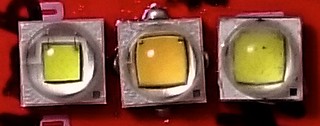
I compared the light from the two PC-amber leds and you can already see on the lighted up die image of the two leds that the ProLight does emit a tiny bit of blue (you can actually dimly see the die through the phosfor layer) while the Cree led shows no blue at all. This difference is what you also see when you illuminate coloured objects with these two leds. If you still want that tiny bit of blue in your PC-amber led depends entirely on your taste and what you will use the leds for (I like it).
ProLight PK2N PC-amber: 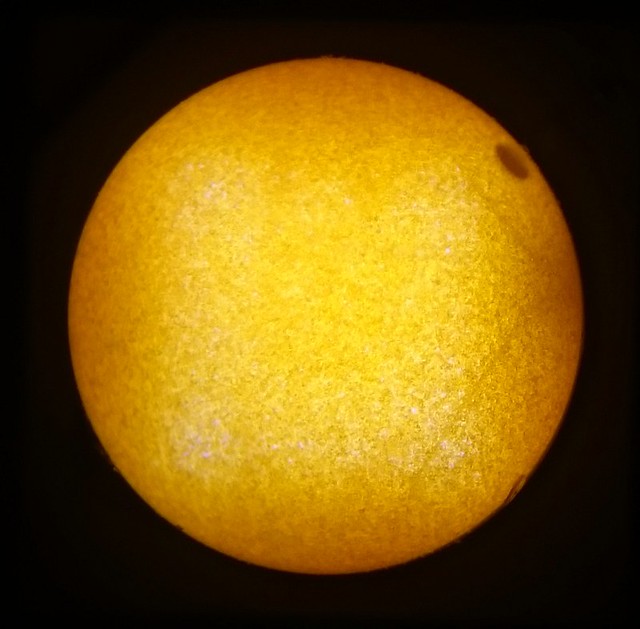
Cree XP-E2 PC-amber: 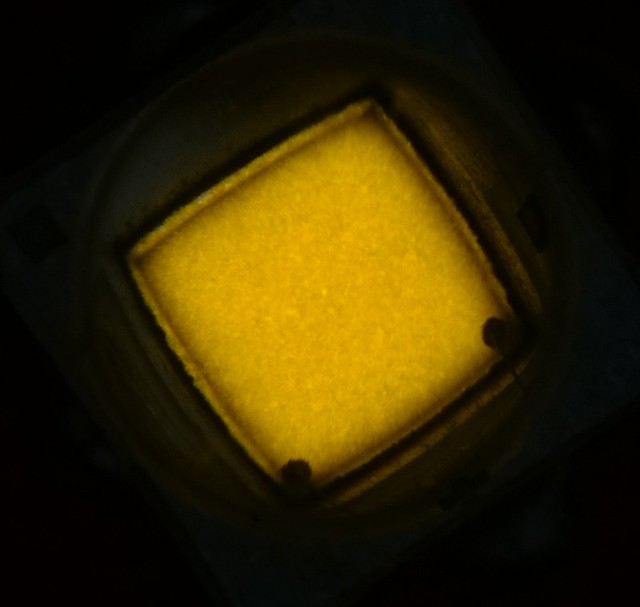
The four leds were easy enough reflowed on 16mm Noctigon boards and put to the test.
The test was done like all my more recent emitter tests. I described it in detail in my XP-L test. , with two minor differences that should not matter significantly for the results: I used my Integrating sphere no. II instead of no. I, and for the current I used a clamp meter, which appears to measure 0.1A lower than the power supply current-reading that I used before.
In summary: 1) just one led of each type was tested, reflowed on a DTP copper board (XP-Noctigon 16mm) 2) I used my large version II integrating sphere with high quality luxmeter, 3) the output numbers and voltages were measured with the led close to 'steady state' for each current, so warmed up and settled, you should be able to get these numbers in a well heatsinked flashlight. Mind that these are output numbers of the bare led, in a flashlight there will be losses from light obstructions, lens and optic, 4) output is in 'djozz-lumen' defined as 1/550 of the output of my Sunwayman D40A on high setting, which I hope is close to the real lumen, but at least is consistent over all my emitter tests done in integrating spheres.
For colour leds the lumen is still a good unit to describe how much light you see with your eyes, but for wavelengths at the edge of the visible human spectrum for which your eyes are hardly sensitive (like the 435nm led tested), it does not tell much about the optical power that the led produces. On top of that, luxmeter sensitvity, that should match the human eye sensitivity, are the least accurate at those wavelengths, I do not even trust my classA-sensor luxmeter fully for 435nm...
Here are the voltage and light output results graphed against the led current, for the 4 leds. The 435nm output number were plotted x10 because of the low values, the curve would be difficult to interpret at x1.
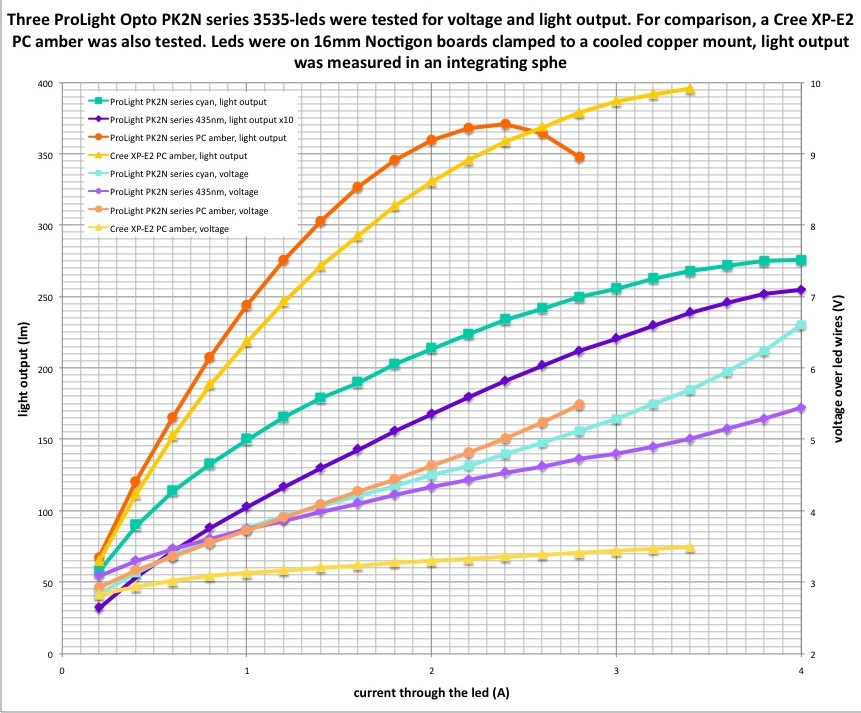
What can be seen:
*all ProLight leds have a more than decent output.
At the same currents, the PC-amber ProLight led delivers a comparable output as the Cree PC-amber led, (but the voltage is clearly higher).
I made a small 16340 direct drive flashlight with the cyan ProLight led and compared it to similar flashlights that I have made before with a cyan LuxeonZ and a cyan Rebel. The three lights do not draw the exact same current (have not measured) but the outputs definitively compare well:
 (left cyan 510nm Rebel, middle cyan 515nm ProLight, right cyan 500nm LuxeonZ)
(left cyan 510nm Rebel, middle cyan 515nm ProLight, right cyan 500nm LuxeonZ)
The Prolight cyan colour proved quite dependent on current btw, at low currents it is much greener (close to 520nm) than at maximum currents (close to 500nm) (over 1A in this flashlight).
I can not really compare the 435nm led output with anything, the output seems fairly good, that is all I can say.
*the Prolight PK2N series have a steep voltage curve: at higher currents the voltage goes up fast, much faster as I am used to for most leds. That is in principle a disadvantage, but it has a bright side in that they can all be used direct drive in a single li-ion flashlight, drawing between 1A and 1.5A, over 2A with 4 NiMh cells in series.
*these Prolights are fairly tough, two of them surviving 4A (did not test the PC-amber at 4A) with the output still climbing slightly. They survived that without noticable performance loss at the lower currents afterwards.
Conclusions
I like these ProLight PK2N leds for colour flashlights, they are cheap enough, perform well, fit the common XP-boards and work well with the modern direct drivers. As for our dear hunters: because of the slightly bigger die, I would expect the throw of the red version (that I have not tested yet) not better than the XP-E2, but you could give them a try anyway :-)
I found them for sale at RS-online, TME, and some on DH-gate, and because they are fairly new and fit in the widespread 3535-niche, I expect them to pop up at other sellers as well.
Thanks for reading!